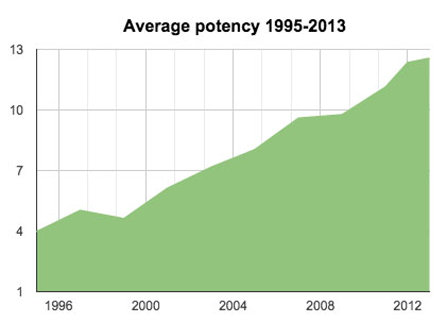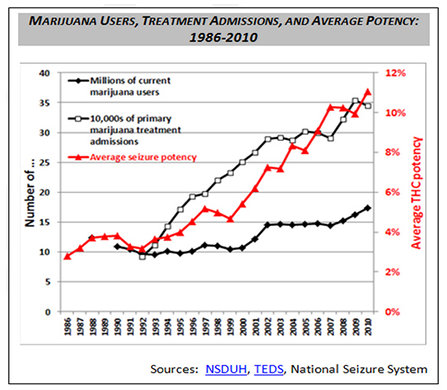Is Increasing Potency Related to the Number of People Going to Rehab for Pot?

By now, most people know that marijuana has gotten far more potent over the last few decades. Here is a chart showing the average potency of marijuana between the mid-1990s and 2013. Between the 1970s and the 1990s, the potency rose from about 1.5% to 4% but then the growth really took off. By 2013, average potency was nearly 13%.
These potency numbers are obtained by testing samples of drugs seized by law enforcement. Note that medical marijuana businesses promote much higher potencies for their products, often in the 25% to 30% range.
Those who feel that marijuana should be legal for everyone to use will tell you that smokers “adjust their dosage” by smoking less. If this were broadly true, then it would seem that as the potency went up, the number of people going to rehab would remain about the same.
That doesn’t turn out to be true. The correct answer is very evident on this next chart. Admissions to treatment rocket up along with potency, while the number of users only increases modestly.

Why Has the Potency Grown so Fast?
More potent marijuana has always been a popular item in sales and has commanded a higher price. In the early 1990s, Canadian drug growers developed a higher-potency strain called BC Bud. It quickly made its way into major US drug markets. Seizures of this drug began to raise the average potency of all samples seized, and both domestic and Mexican cannabis growers began to adopt the same practices that made BC Bud so strong. They would have to follow suit just to stay competitive. Now, potency is a major factor in the sales of marijuana. In the U.S., potency as high as 36% has been found. That’s nearly three times the average.
Surely, there will be some limit to the amount of THC (the primary intoxicating ingredient in marijuana) but so far, it has not been found. A report from Australia describes potency levels of 40% from seized marijuana. This is a fearsome potency that could have disastrous effects on users both in Australia and if it makes its way to the U.S. We could see even more people arriving at rehab, asking for help, as well as more people needing emergency room, doctor or mental health care help for the severe adverse effects possible from this highly potent drug.
Sources:
 ®
®